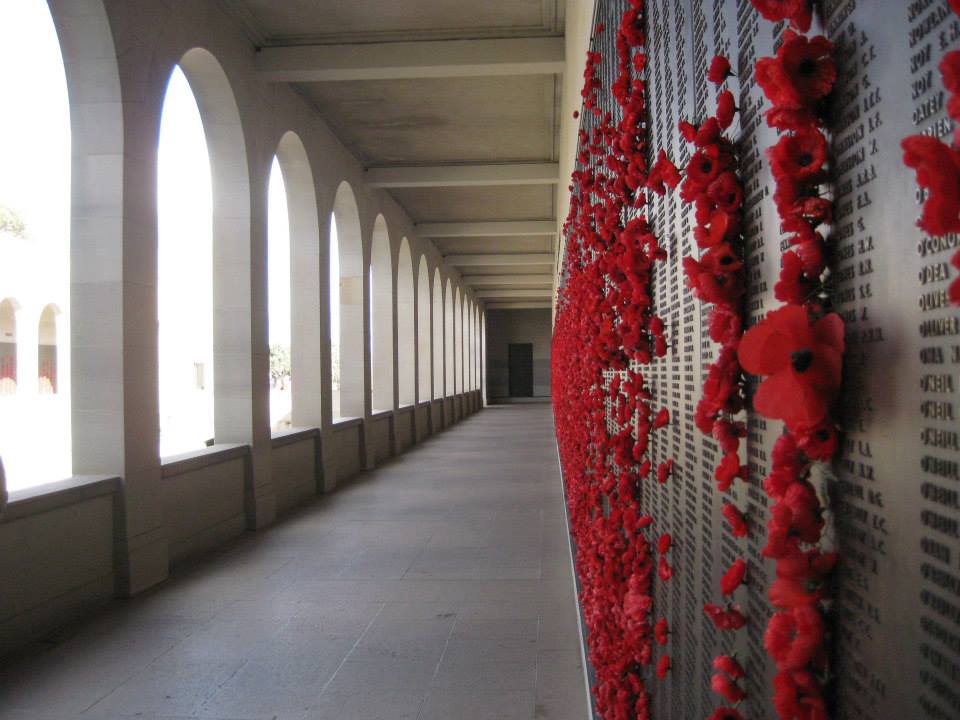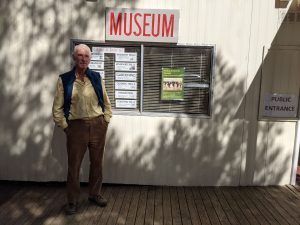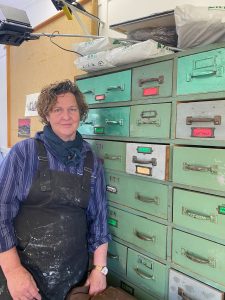Commemorating 100 years since Gallipoli as an AWM volunteer
 Belinda McKeon speaks to a tour guide at the Australian War Memorial to see what the centenary year means to them.
Belinda McKeon speaks to a tour guide at the Australian War Memorial to see what the centenary year means to them.
I stare into the rich pencil lines and shading that create a worn and tired face. A woman, but not one in a nurse’s uniform like the other women displayed in the Australian War Memorial. Why is this face among the photos of soldiers and old uniforms in the “Australia in the Great War” Gallery?
Anne Chisholm is her name. The mother who dropped everything and travelled to Cairo after learning her son had been wounded in action. She observed the lack of facilities for the soldiers and opened a canteen for them with two other women. They served 1000 meals a day. Michael Dowsett, who sits across from me in the War Memorial café, tells me this is his favourite part of the new World War One Gallery that opened in December.
His eyes are kind and wise, gleaming with years of experience. Mr Dowsett is a volunteer tour guide at the War Memorial and I tagged along to one of the Australia in the Great War tours he led. He is impressed with the major contribution that Mrs Chisholm made for someone not in uniform, and likes to make a point of her on every tour he takes.
Mr Dowsett became a volunteer five years ago after he retired to convey his knowledge of military history to others. However, the Gallipoli Centenary year is to him like many others: very special.
“I have great uncles that served in the First World War but I don’t know much about what they did or anything and it’s made me interested to find out a little bit about them,” he says. “I think that’s a common experience of a lot of visitors that come.”
Mr Dowsett believes guides help maximise the experience of visitors by helping them find what they are looking for. By having the knowledge to explain different events in detail, guides like him are able to make it a fulfilling experience for the visitors. They are especially important and helpful to those searching for information on their family members.
We stop in front of George Lambert’s huge painting that depicts the landing of Australian Soldiers on ANZAC Cove. Soldiers struggle on the rough terrain, pulling themselves higher on the impossible rocky hills. They are wearing their iconic khaki uniforms and slouch hats, but Mr Dowsett points out the majority actually wore British felt caps. We continue along in the chronological tour.
Mr Dowsett made an immediate impression on me as I met him while waiting for the tour to begin. He was genuinely very interested in learning about the different visitors and finding out where their travels had led them. He was more eager to learn about me and have a conversation than speak about himself. It took me a while to find out he was previously in charge of the health services of the Australian Navy.
After some further research I discovered he previously held the rank of Commodore and made some major contributions to the Navy in his thirty years of service. As the patron of the Australian Defence Force Academy Rugby Club, he has a trophy named after him and is well-loved by young members of the Defence Force in Canberra.
Mr Dowsett tells me that the largest group of volunteers at the War Memorial were previously in the military, the second largest group being history teachers. Last year there were 230 volunteers.
The Australian War Memorial is one of the many tourist attractions in Canberra and over 920,000 people from the around the globe visited last year. The Gallipoli centenary year is sure to pull even larger numbers.
Visitors who share their stories about relatives who served in the war add to the narrative. “Each day you never know what you’re going to get,” Mr Dowsett explains.
The Australian War Memorial is unique as it is the only one of its kind to combine art, a shrine, a museum and an extensive archive. According to the website, its mission is to “assist Australians to remember, interpret and understand the Australian experience of war and its enduring impact on Australian society.”
As we wander around the exhibition a taxidermied camel immediately grabs my attention. Mr Dowsett tells us the story of a water carrier who brought water from Alexandria in Egypt, 600km away from the soldiers because of the water shortage. There is a palpable shudder around me as he speaks of the soldiers who were infested with lice and disease and placed themselves in danger to quench their need for a bath.
Meeting family members of those displayed in the War Memorial during tours makes volunteering a special experience. Mr Dowsett shared with me a favourite story of a woman who recently visited the War Memorial whose father was one of the pilots in the iconic Lancaster Bomber G for George. When she last visited she was able to sit in the pilot’s seat of the plane.
Apart from guiding tours, volunteers at the Australian War Memorial also conduct their own research to become more familiar with the different galleries and individual stories. Each guide gives a unique version of the different tours that are affected by their interests and favourite stories. Mr Dowsett tells me the volunteers are “encouraged to do your own research because if you went to that First World War gallery in an hour’s time you’d have a different story.”
Mr Dowsett points at the Battle of Pozieres diorama. The once-blue sky is filled with smoke and the French landscape is decimated with the scars of war. The frozen moment in time depicts several deceased soldiers that make up just a few of the seven thousand Australians that lost their lives here in just six weeks.
According to the tour, dioramas were designed and created in the 1920s to help families understand where and how their loved ones died as they were often not able to travel to the original places. The one survivor portrayed in the “Battle of Pozieres” diorama advised artists about the scene and tragically committed suicide soon after. The dioramas are incredibly realistic, not showing a hint of their age which is now close to one hundred years.
Mr Dowsett is very interested in these dioramas and other artworks. He is part of a small volunteer sub-group that call themselves the “art mob”. He informs me that “once every three weeks we spend a couple of hours with one of the curators and they explain the artworks we have.”
These sub-groups contribute to the great social aspect the many retiree volunteers appreciate. Mr Dowsett tells me he didn’t realise the social value of work until he had retired and volunteering provides a way to fill this void.
The Mont St Quentin diorama transfixes me with the eerie sounds of wind over the ruined landscape. Dead trees litter the high ground where many injured soldiers lie, one with his shirt open clutching a bullet wound on his chest. Dark clouds loom over, the digitised background that replaced the original allows the sky to be dynamic and ever-changing.
For Mr Dowsett, a substantial part of his thought process towards World War One (WWI) stems from his own family’s experience. He was not handed down anything from his great uncles who fought, but has been able to find some photographs and information online. As he ponders his mother’s life through WWI, The Depression and WWII, he suggests we will probably never have a generation of people like that ever again. “That’s in terms of impact to my own family life which I wasn’t really interested about until I started thinking about that,” he says.
Mr Dowsett comes across many visitors who have been handed down a diary or some photographs but are no longer sure who the artefacts and pieces of history belong to.
We enter the 1918 section of the exhibition. Perfectly preserved uniforms from the different armies stand behind Mr Dowsett. One uniform is well-worn and covered in mud. We are informed that neither the uniform nor the mud are replicas but the original of an Australian soldier. A knife, fork, tin of tobacco and metal helmet sit before us. Australians were encouraged to bring things home with them in the last few years of the war for historical purposes.
Mr Dowsett retold a story of a recent tour where he was surprised at some young teenagers’ reactions of shock to the cigarette case which had been presented to a soldier departing a small country town:
“It’s a realisation that things have changed and everyone smoked and cigarette cases would be quite a valued thing so it’s realising that base knowledge is not what you might assume. Anything that we can add, adds to those people’s knowledge.”
Quite often he is astonished at the lack of knowledge on well-known characters and stories from WWI.
“I was with a group of first year cadets from the Defence Force Academy and in that week I was with about 90 of them and I took them around to the statue of Simpson and the donkey and said, ‘Who’s this?,’ and only two people knew. That was a surprise to me.”
Although Mr Dowsett is often surprised by the minimal knowledge visitors he speaks to have, he is excited to be able to assist them to gain a better understanding of Australia’s military history. Working at the Australian War Memorial is a joy for him. “I think a common feeling among a lot of the volunteers is we’re privileged to be here.”
On my several trips to the War Memorial I had noticed the predominance of elderly couples and distinct lack of young adults and teenagers. I ask Mr Dowsett if this is a trend. He explains that as it is not currently school holidays there are very few family groups and young people visiting. “This is obviously when seniors are wandering around the place and I’d be surprised if we had family groups here. You see the school children but they’re separate, they’re in Canberra as part of the school curriculum. But school holidays is a different picture.”
Younger Australians understandably do not connect with the stories of the War Memorial in the same way as those whose parents or grandparents fought in the First and Second World Wars. However, some strong interest in military history still exists.
We continue to wander around the 1918 section, the last year of WWI. Nearly 60,000 Australians died in war and another 60,000 in the ten years following from injuries. Most of the deceased men were single, meaning many women of the time were never able to marry. There was no known burial for 20,000 of these deceased men. The effects of the war on the other side of the world to Australia would impact the country for decades to come.
The 100th anniversary since the landing of Australian soldiers at Gallipoli is this month. As Michael Dowsett put it, “We’re not celebrating, but commemorating 100 years.”
I pause on my way out and purchase a poppy, placing it among the thousands that surround the names of those who died in WWI. As I ponder the role that these soldiers played 100 years ago in the war, I realise the importance of the volunteers and historians who share their story. Without them we may have known nothing about the events at Gallipoli 100 years on.





Be the first to comment!